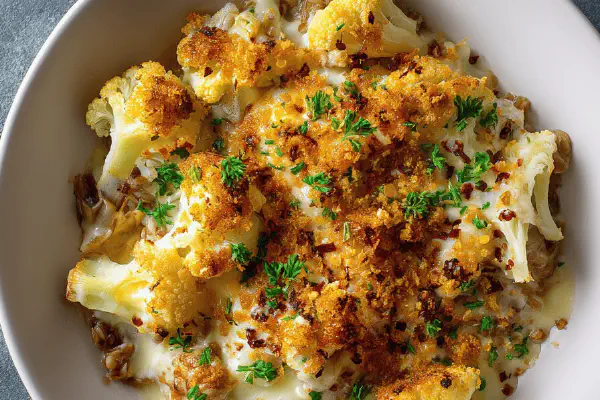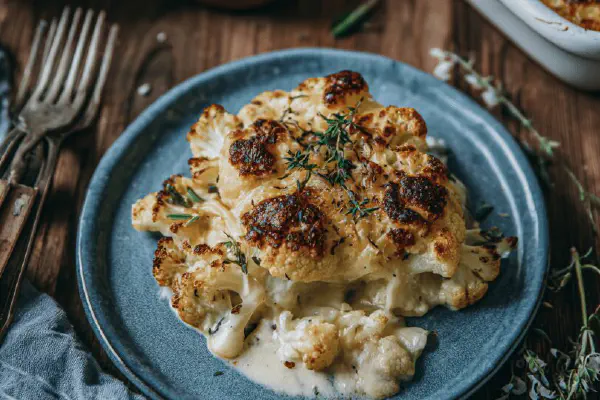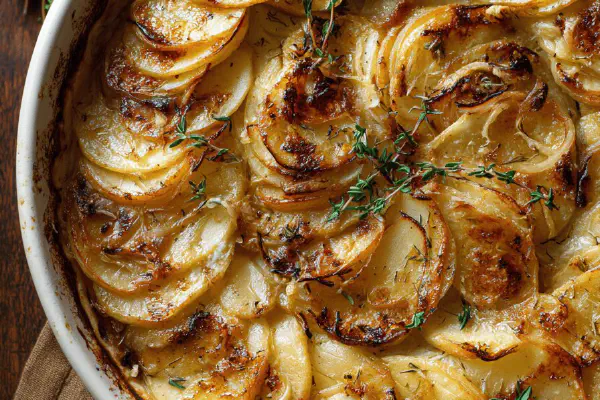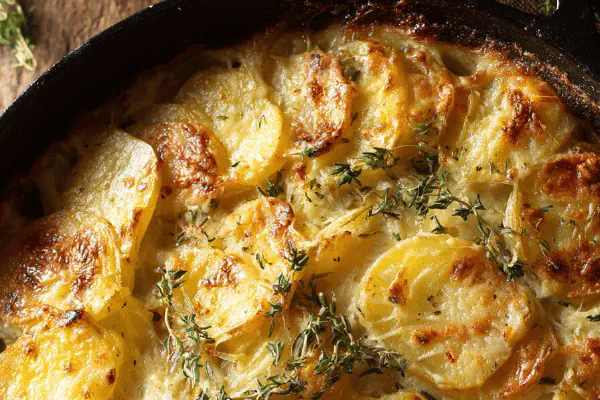Cauliflower Mornay Sauce

By Emma
Certified Culinary Professional
Ingredients
- 2 French shallots, finely chopped
- 1 clove garlic, minced
- 70 ml (1/3 cup) unsalted butter
- 65 ml (1/4 cup plus 1 tsp) all-purpose flour
- 500 ml (2 cups) whole milk
- 250 ml (1 cup) sharp cheddar, grated
- 2 pinches ground nutmeg
- 15 ml (1 tbsp) chopped fresh parsley
- Salt and black pepper to taste
- 1 litre (4 cups) cooked cauliflower florets
About the ingredients
Method
- Start heating a heavy-bottomed saucepan. Melt butter over medium heat. Add the shallots and garlic. Stir often until softened, glossy but not browned — about 3 minutes. Aromatics release a mild sweetness here; don’t rush or let brown.
- Lower heat slightly. Sprinkle in flour, whisk or stir vigorously to coat shallots and create a blond roux. Cook 3 minutes more. The raw flour taste must vanish but color stays pale.
- Gradually add the milk in steady stream while whisking continuously. This prevents lumps. Once all milk is in, raise heat to medium-high. Watch carefully — sauce will bubble, thicken, and cling to spoon edges in about 8-10 minutes.
- Remove from heat, stir in cheese bit by bit until fully melted. The sharp cheddar adds bite but melts with creamy smoothness. Toss in nutmeg and parsley. Salt and pepper to taste. If sauce feels thick beyond coating limits, thin with splash of milk or cream. Should nap the back of a spoon.
- Arrange cooked cauliflower in serving dish. Pour sauce evenly over. Serve immediately while the cheesy warmth contrasts with tender veggie.
Cooking tips
Chef's notes
- 💡 Butter must melt gently temperature steady. Shallots and garlic soften slow, glossy but no color change. Aromatics release sugars here; rushing means bitterness appears later. Roux needs light whisking—flour coats butter, no lumps allowed. Keep heat moderate; too hot burns flour raw taste stays. Stir longer if smell raw notes come out. This base sets sauce profile.
- 💡 Add milk gradually; constant whisking breaks clumps mid-stream. I’ve learned lumps vanish when patience rules. Start slow stream until batch fully absorbed before adding more. Heat low then raise once mixed. Sauce bubbles gently—watch spoon trails; should coat with thin pale layer. Too thick? Use splash milk bit by bit. Texture matters more than timing here. Visual cues beat clocks every time.
- 💡 Sharp cheddar melts with some resistance unlike Gruyère. Add in chunks or shreds slowly off-heat first, then on low warming to prevent grainy texture. Cheese quality can ruin sauce fast. Fresh block, not pre-shredded, helps. If grainy, warm gently while whisking until smooth. If too salty, reduce added salt next time. Nutmeg always last ingredient; adds subtle warm note. Skipping it leaves flavor flat, missing depth.
- 💡 Cauliflower must be drained well after cooking—leftover water thins sauce disastrously. Steamed or microwaved florets work fine but test tenderness first; flakes easily but keep shape. Sauce thick enough should cling, coat with confident layer. Test with spoon: drag edge and see line remain, no quick fill-in. Pour sauce while hot over veggies; coating sets as it cools. Holds melty within. If cooled, reheat slowly to avoid separation.
- 💡 Parsley isn’t just garnish. Tossed at end adds freshness cutting through richness and heavy cheese notes. Chop fine; sprinkle over the top or stir lightly for slight texture contrast. Salt cautiously because cheese already salty. If using plant milk alternatives, full-fat oat is closest in mouthfeel but texture shifts. May require slight extra flour or longer cooking to thicken. Adjust seasoning as plant milk changes base flavor profile.
Common questions
How to fix lumpy sauce?
Whisk off heat immediately. Add milk slowly, never dump at once. Strain if stubborn. Blender rescue works. Temperature balance key. Too cold thickens fast unevenly; too hot clumps faster. Patience breaks lumps down.
Can cheddar be swapped?
Yes but texture changes. Gruyère melts creamier, nutty note more subtle. Use mild cheddar too sharp for some. Mixing cheeses works too—balance melt and bite. Avoid processed cheese. Keep salt in mind with sharp variants.
Why sauce grainy sometimes?
Cheese melting temp crucial. If added at too high heat, proteins seize. Gradual off-heat melting helps. Also, low-fat shredded melts worse. Stirring gently breaks lumps but avoid harsh whisking once cheese in. Warm gently, don’t boil after cheese.
How store leftovers?
Seal tight, fridge up to 3 days. Reheat slow on stovetop, add splash milk if thickened too much. Microwave works but risk drying edges. Freeze not recommended - cheese sauce texture breaks. Cauliflower may soften more stored; best eaten fresh.



